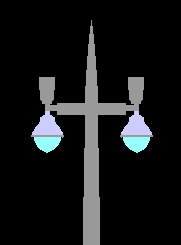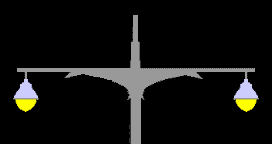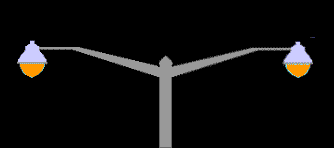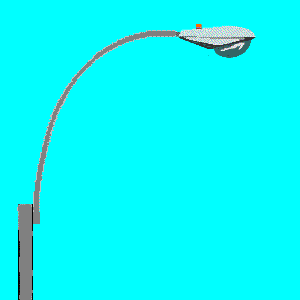New York City Street Light Trivia
 Do you know that
the normally incandescent Westinghouse "cuplight" light fixtures occasionally showed up
with mercury vapor bulbs? The Clearview Expressway & the
Long Island Expressway (LIE) east of the Clearview had them. So did the city
end of the New England Thruway, the Manhattan Bridge & Williamsburg
Bridge. They survived on the New England Thruway, around the
Pelham Parkway exit, well into the 1980's, somehow escaping the insatiable
appetite of the Donald Deskey "Bigloop" standards. They were eventually gobbled up by
a mutant relative of theirs, giant cyclop cuplights that could
light up the Atlantic ocean. Do you know that
the normally incandescent Westinghouse "cuplight" light fixtures occasionally showed up
with mercury vapor bulbs? The Clearview Expressway & the
Long Island Expressway (LIE) east of the Clearview had them. So did the city
end of the New England Thruway, the Manhattan Bridge & Williamsburg
Bridge. They survived on the New England Thruway, around the
Pelham Parkway exit, well into the 1980's, somehow escaping the insatiable
appetite of the Donald Deskey "Bigloop" standards. They were eventually gobbled up by
a mutant relative of theirs, giant cyclop cuplights that could
light up the Atlantic ocean. Those on the ancient Manhattan Bridge, were apparently set in place in the 1950's, when the city planned to smash an expressway from that span, to the Holland Tunnel. They managed to stay alive, on the Brooklyn bound side, until the mid 1990s. |
 These lights were more distinguished by their mini-elliptical mast arms
than by their fixtures. They were like cute little baby lights,
butchered by an evil baby hating DOT. A handfull remain on the
abandoned right of way, of the expressway that never was, at
the Manhattan foot of the bridge.
These lights were more distinguished by their mini-elliptical mast arms
than by their fixtures. They were like cute little baby lights,
butchered by an evil baby hating DOT. A handfull remain on the
abandoned right of way, of the expressway that never was, at
the Manhattan foot of the bridge. |
 Even
the unbelievably ugly, misbegotten, decrepit West Side Highway, or more formally the Miller Highway in
Manhattan had mercury vapor cuplights. Not that Miller would have complained toward the end about most people not associating him with the elevated monstrosity, but I digress as usual.
The Westinghouse cuplights looked particularly weird on the unusual poles that graced that road, if the word "grace"
is not gilding the lily a bit. Apparently the mercury vapor cuplights
required special ballasting, or something, that forced the DOT
to install these wierd crowns on top of the cups. Even
the unbelievably ugly, misbegotten, decrepit West Side Highway, or more formally the Miller Highway in
Manhattan had mercury vapor cuplights. Not that Miller would have complained toward the end about most people not associating him with the elevated monstrosity, but I digress as usual.
The Westinghouse cuplights looked particularly weird on the unusual poles that graced that road, if the word "grace"
is not gilding the lily a bit. Apparently the mercury vapor cuplights
required special ballasting, or something, that forced the DOT
to install these wierd crowns on top of the cups.If these poles didn't look spooky to begin with, their spires combined with these ballasts to make them look like demonic pitchforks. Most of the pitchforks hit the dust, along with the greater part of their miserable highway, in the mid 1970's, after a truck fell through a rather large pothole, forcing the closure of New York City's first elevated exp-messway. Naturally, now that they're gone, I miss the PitchForks terribly. |
| Closure of the road didn't mean instant demolition. It took years until the city decided that the road was too far gone to rehab. Environmentalists and neighborhood groups then blocked the proposed replacement, the infamous Westway. The rotting hulk of the old West Side Highway was eventually torn down in stages, but the section stretching from the 40's to 57th St. lingered on for years. My friends and I took in many a pier concert from that highway. It was a great place to hang out and gave great views of the concerts below. A handful of pitchforks were still left, at the far northern end above 57th Street leading into the Henry Hudson Parkway, when that sole surviving section was rebuilt. |
 The mercury cups also appear all over Long Island,
to this day. They're typically attached to telephone poles that
always seem to be leaning back like lazy smart-ass bums. I guess
when a light is that old, it can do as it pleases with impunity.
I don't know whether to applaud Long Island for conserving these
illuminous treasures, or blast them for being so cheap. The mercury cups also appear all over Long Island,
to this day. They're typically attached to telephone poles that
always seem to be leaning back like lazy smart-ass bums. I guess
when a light is that old, it can do as it pleases with impunity.
I don't know whether to applaud Long Island for conserving these
illuminous treasures, or blast them for being so cheap. |
 The lights that I've lovingly dubbed "The
Whitestones" first appeared on that august span in the late
1930's. They were then employed on major highways built through
the early fifties, when the more functional and austere elliptical "crook-arms"
took over. The "Stones" graced the Gowanus, BQE and
Van Wyck Expressways, the upper roadway and ramps of the 59th
Street Bridge, the Brooklyn Bridge approaches, the Henry Hudson
and Atlantic Beach Bridges, the lower East River Drive and the
LaGuardia Airport entrances. The lights that I've lovingly dubbed "The
Whitestones" first appeared on that august span in the late
1930's. They were then employed on major highways built through
the early fifties, when the more functional and austere elliptical "crook-arms"
took over. The "Stones" graced the Gowanus, BQE and
Van Wyck Expressways, the upper roadway and ramps of the 59th
Street Bridge, the Brooklyn Bridge approaches, the Henry Hudson
and Atlantic Beach Bridges, the lower East River Drive and the
LaGuardia Airport entrances. |
 These lights proved fairly resilient, in a city
that seemed to take pride in how fast it could remove anything,
that heaven forbid, might cast a little charm on it. They managed
to hang on the Van Wyck Expressway well into the 1970's, as they also did
on the 59th St Bridge and scattered pockets of the Brooklyn Queens
Expressway. These lights proved fairly resilient, in a city
that seemed to take pride in how fast it could remove anything,
that heaven forbid, might cast a little charm on it. They managed
to hang on the Van Wyck Expressway well into the 1970's, as they also did
on the 59th St Bridge and scattered pockets of the Brooklyn Queens
Expressway.The Van Wyck had lost more of them to bad drivers, rather than bad policy. The Whitestones lived in uneasy peace with the crookarms that often replaced the casualties. |
 They reinvented
themselves, in both the mercury and sodium vapor eras, on the
Whitestone, Brooklyn and 59th Street spans, unlike many younger
poles elsewhere that never lasted long. They reinvented
themselves, in both the mercury and sodium vapor eras, on the
Whitestone, Brooklyn and 59th Street spans, unlike many younger
poles elsewhere that never lasted long.Sadly though, they were fired from their positions on the 59th Street Queens ramps and recent construction has killed off the remainder on the East River Drive (FDR Drive) and left only a skeleton crew on the Brooklyn Bridge approach. An occassional speciman can also still be glimpsed at the Henny Hudson Parkway & LaGuardia Airport. They still persist on their namesake bridge, for the most part holding humongous LPS anti-fog vapor fixtures. Those with a sharpshooter's eye can detect two different versions of the poles. |
 In the 70's, the poles
literally cut off their arms, right and left, to stay alive.
On both the Van Wyck Expressway and BQE, the arms that give these poles
95% of their grace, were cut off, replaced by the hideous quarter
loop uplift arms that Kojak fans are so familiar with. A few are still left,
on the more moribund sections of the BQE. The last of the Q-looped
Van Wyck Expressway Whitestones, as well as their crookarm enemies, disappeared
in various construction projects over the last decade. Fans of
the "Stones" should look for the originals, in the
1952 film, "The Eddie Duchin Story". The scene with
them takes place on the East River Drive (also known as the FDR)
around Grand Street, on the Lower East Side. In the 70's, the poles
literally cut off their arms, right and left, to stay alive.
On both the Van Wyck Expressway and BQE, the arms that give these poles
95% of their grace, were cut off, replaced by the hideous quarter
loop uplift arms that Kojak fans are so familiar with. A few are still left,
on the more moribund sections of the BQE. The last of the Q-looped
Van Wyck Expressway Whitestones, as well as their crookarm enemies, disappeared
in various construction projects over the last decade. Fans of
the "Stones" should look for the originals, in the
1952 film, "The Eddie Duchin Story". The scene with
them takes place on the East River Drive (also known as the FDR)
around Grand Street, on the Lower East Side. |
|
Another movie, from the late 1940's, about juvenile delinquents, has
a good shot of them on an obscure bridge linking Queens with
Roosevelt Island, but I can't remember the name. They are probably
visible, albeit with vapor fixtures, on the opening credits of
Taxi, on the 59th Street Bridge's upper roadway, but I'm not
in the mood to watch it again, to see if that's so. Yet another 1950's movie, involving a mother racing to redeem her child from kidnappers, shows her frantically looking out for Kappock Street on the Whitestone laden Henry Hudson Parkway in the Bronx. |
